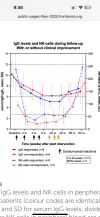@Jaybee00
They discussed this some time ago as the basis for their B-cell depletion experiments. I simply assumed that their view on this topic has not changed since then. You can read it here:
Yes, it’s complicated. I’ve just read a bit more about the blood tests for these antibodies, and the methodology doesn’t seem to be properly standardized. The risk of false negatives is definitely real, and who would want to lose hope if, in the end, the result might not even be clinically meaningful.
That said, the hypothesis of impaired oxygen delivery and microcirculation would certainly support a role for GPCR antibodies. But as always, there is still too little evidence to draw firm conclusions. I suppose all that’s left is to wait for the Phase 2 data.
It would still be very interesting if they measured the antibody levels to see whether the participants are generally positive
They discussed this some time ago as the basis for their B-cell depletion experiments. I simply assumed that their view on this topic has not changed since then. You can read it here:
Yes, it’s complicated. I’ve just read a bit more about the blood tests for these antibodies, and the methodology doesn’t seem to be properly standardized. The risk of false negatives is definitely real, and who would want to lose hope if, in the end, the result might not even be clinically meaningful.
That said, the hypothesis of impaired oxygen delivery and microcirculation would certainly support a role for GPCR antibodies. But as always, there is still too little evidence to draw firm conclusions. I suppose all that’s left is to wait for the Phase 2 data.
It would still be very interesting if they measured the antibody levels to see whether the participants are generally positive
Last edited:

